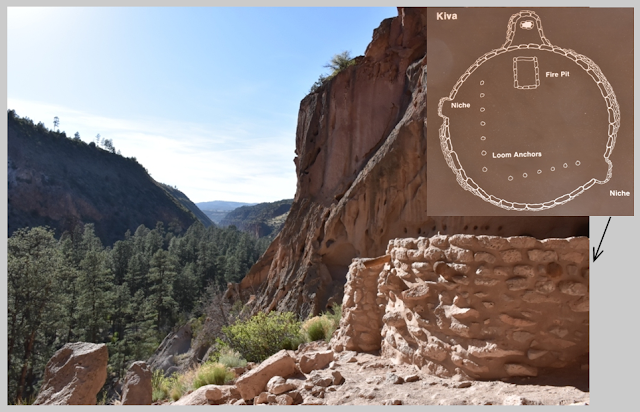Bandelier is a small gem located
in the mountains northwest of Santa Fe in
northern New Mexico .
It is close to Los Alamos National Labs and the Valle Caldera. The park
preserves both archaeological features of the Ancestral Pueblo people (much
like Mesa Verde), and a mountainous landscape of forest and high desert
savannah.
 |
| Cave dwellings at Bandelier. A few are open to visitors via ladders. Ar right: view from a cave dwelling with the ruins of a settlement in Frijoles Valley visible below the forest. |
Starting at the visitors center, I
took the main trail to see the ruins of the village and the cave dwellings that
the former inhabitants carved into the soft sandstone rocks that line the northeast
side of Frijoles Valley
 |
| View of Frijoles Valley from a sandstone alcove where the ruins of a ceremonial Kiva were located. Inset at right is a NPS diagram of the layout of the kiva. |
 |
| Box elder with developing fruits. |
I continued hiking up Frijoles Canyon California ),
Douglas fir, narrow-leaf cottonwood, and maybe species of Salix and Tamarix.
The valley had a number of
blooming species of plants too including a lovely shrub (western chokecherry, Prunus virginiana). Each plant had
numerous inflorescences several inches long with dozens of fragrant white
flowers. Another very attractive species growing in forest areas was a member
of the pea family (golden pea, Thermopsis
rhombifolia), having spikes of yellow-flowers (suggesting a species of
lupine), but leaves with three main leaflets (unlike other lupines that I am
familiar with where there are typically many leaflets). In the more open
grasslands, an attractive aster, with golden and red ray flowers could be
found.
Reference
Blackwell LR. 2006. Great Basin Wildflowers. The Globe Perquot Press, Guilford , CN
 |
| The very fragrant and beautiful flowers of Prunus virginiana. |
 |
| Frijoles Creek. |


No comments:
Post a Comment